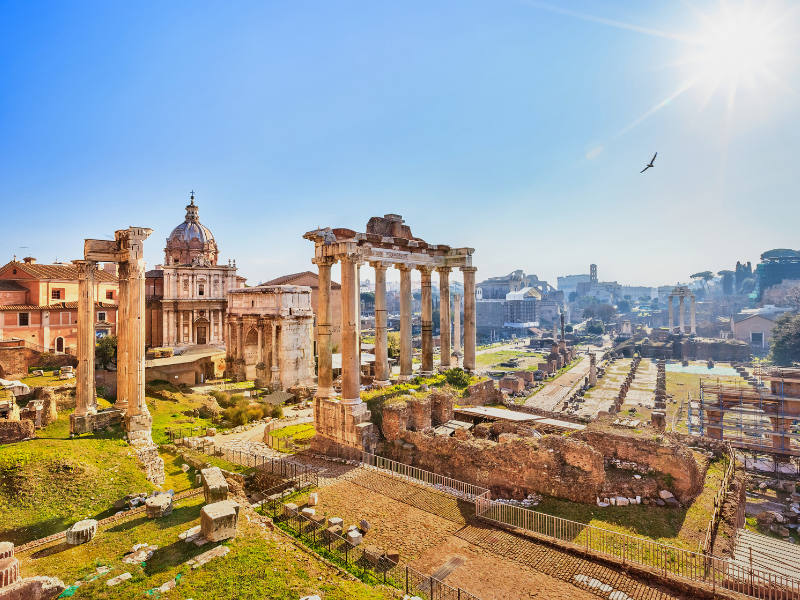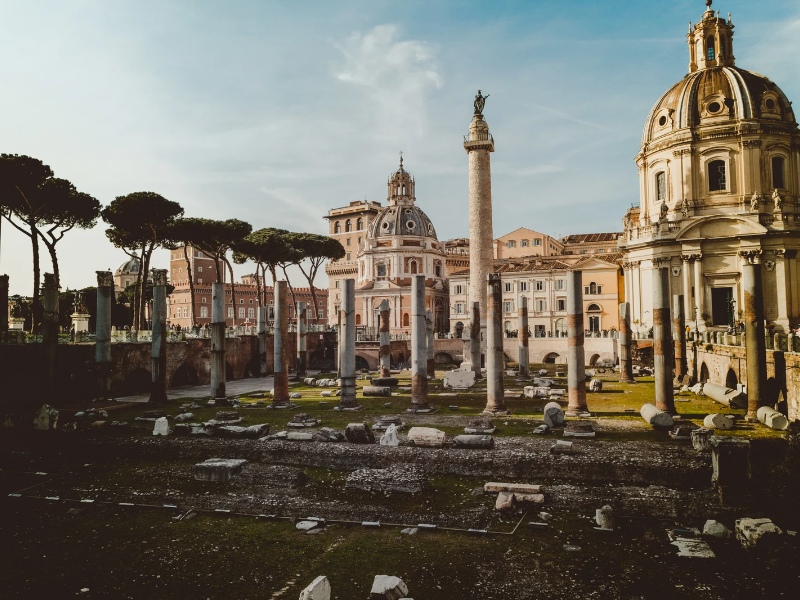The Roman Forum is located in the center of modern Rome. This complex of ruins was once the hub of political, commercial, and religious life in ancient Rome.
Historical Context
Origins and Growth
In 7th century BC, The Roman Forum (Forum Romanum) started out as a simple market place before gradually becoming the bustling heart of public life in Rome. At first it was just a swampy valley between Palatine Hill and Capitoline Hill but eventually it was drained and turned into an open-air space for hosting Rome’s most important political, legal and business activities. Temples were constructed over time along with basilicas and monuments until this became symbolic centre representing all parts of empire.
Significance In Architectural Terms
Roman Forum showcased various architectural styles that reflected both its own growth story as well broader changes within city which had seen significant expansion over centuries . From early Republican buildings through to monumental Imperial structures; so too did architecture here represent power & majesty associated with ancient world powers. The central square enclosed by temples,basilicas & other public buildings served as meeting point for citizens who gathered there for political debates or religious ceremonies among other social events .
Cultural Significance
More than just a collection of buildings ,the roman forum was nerve centre from where romans governed their vast territories. Thousands came daily to work ,walk around ,meet friends or do business transactions during this period when it served such purposes.The Senate met here to decide matters that affected not only immediate but also long term future since generals celebrated victories while citizens participated actively in life within city walls .These things show us how powerful this place must have been – fate empire being decided at one end while other end saw achievements being commemorated through various monuments .
Design And Architectural Features
Structure and Layout
The forum of rome is a large area which stretches from capitol hill to palatine hill .It has various important buildings surrounding its central square such as temples ,basilicas and public spaces.Its layout reflects multi-functional nature with different areas set aside for politics,religion ,commerce etc.The main street called Via Sacra passed through this place connecting colosseum to capitoline hill where victorious generals used to pass during their triumphal processions.
Styles Of Architecture Used
There are different architectural styles seen in the Forum ranging from simple austere forms found during early republic period up-to grandiose structures seen under empire rule. Classical style was used in building temples like Temple of Saturn and Temple of Vesta which had columns plus pediments reflecting influence Greek architecture .Basilicas were designed as large open spaces for public gatherings hence their huge arches together with vaulted ceilings that made them engineering marvels at that time eg Basilica Maxentius and Constantine.

Restoring and Safeguarding
Throughout time the Roman Forum disintegrated as Rome city crumbled. They destroyed numerous constructions, utilizing their components to build new edifices. Nevertheless, in the eighteenth and nineteenth centuries people found out about this place again and have taken measures towards preservation and reconstruction of old memorials. Currently it is considered an archaeological reserve of international importance with continuous restoration activities that allow tourists see its former splendor.
Principal Monuments and Sites
Saturn Temple
Summary
Saturn’s temple is the oldest and very well recognized establishment in the Roman Forum. It was initially built in 497 BC in honor of Saturn – the god of wealth as well as agriculture. The treasury house of Rome and the place for crucial state rites were held here. Remaining eight columns speak about eternality of ancient Rome which are located behind Forum.
Architectural Features
The classical-style construction (with columned porch and raised podium) Temple of Saturn has columns made from travertine, a kind of limestone commonly used in buildings throughout ancient Rome. An inscription on the architrave commemorates rebuilding after fire during later restorations in 4th century AD. Being situated at western end made it prominent among other structures around city-scape.
Septimius Severus Arch
Summary
Raised by AD 203, this triumphal arch celebrated victories won by Emperor Septimius Severus over Parthia (Iran). Among all monuments in Forum area it is considered as one which kept best its original form and structure being masterpiece both sculptural work representative for period when Romans were at their peak achievement architectural art. It stands on north side close to central square acting also like grand entrance there.
Engravings and Reliefs
Inscriptions praising him are accompanied with detailed representations showing different scenes from campaigns fought by him against Parthians carved into slabs set against sides lining passage through archway; these tell stories such as addressing troops before battle or celebrating victory afterwards etcetera. There is another inscription that pays tribute not only to him but also his sons Caracalla joint rulers with father Geta before they killed each other so the whole thing represents imperial power apart from being reminder about military strength possessed by empire.

Maxentius Basilica & Constantine Basilicae
Summary
This building project took place towards end Ancient Rome; largest ever constructed here, it marked last large-scale works undertaken during Roman times. Begun by Emperor Maxentius AD 306 and finished off under Constantine rule following victory over Maxentius at Mulvian Bridge AD 312/13; treated as public meeting space used for legal proceedings among other civic functions.
Greatness of Design
Basilica of Maxentius was humongous – measuring about one hundred meters long by sixty-five wide: central nave flanked on either side with an aisle covered in series of large barrel vaults. The colossal columns supporting ceiling numbered eight while interior decoration included mosaics marble etcetera; Christian church architects later drew inspiration from its scale and design so did planners constructing various public structures within empire.
Vesta Temple
Summary
Temple of Vesta ranked among the most significant religious sites in ancient Rome. Vesta was the goddess for hearth and home worshiped here where a fire burned that symbolized life eternal as well continuity nation statehood. While it had round form unlike many temples around city which were rectangular only few such buildings remained closed to general public throughout history Roman religious architecture
Sacred Vestals
The Temple of Vesta’s sacred flame was kept by the Vestal Virgins, who were a group of priestesses chosen from Rome’s noblest families and served for 30 years. The Vestal Virgins were highly esteemed in Roman society and played an important part in religious ceremonies. They lived in the House of the Vestals nearby, also located on the Forum, where they kept the fire burning and performed rituals for the city’s prosperity.
Rostra
General
The Rostra was a platform in the Roman Forum where public speakers spoke to crowds. It received its name because it had ship prows (rostra) mounted on its front which were taken as trophies from ships defeated by Rome. Many famous speeches have been made there including those by Julius Caesar and Cicero; this made it become the focus point of life within public eye during ancient times.
Historic Speeches
Rome’s greatest orators would speak to their people here along with making any major announcements that needed addressing towards them.It is also where mark Anthony gave his famous funeral speech over Julius Cesar, which stirred up emotions amongs everyone there causing power struggle between him and others afterwards.The importance behind this place is not only about being able to speak freely but also being heard out by all who were present at such events since it acted as one central location capable of attracting masses.
Visiting The Roman Forum
Position and How to Get There
The Roman Forum is positioned in the middle of Rome, between Capitoline Hill and Palatine Hill. Public transport provides convenient access to the forum;
- Metro: The Colosseo metro station (Line B) is the nearest stop to the Roman Forum.
- Bus: Some bus lines such as 75, 81, and 175 make stops near the Forum.
- Car: There is limited parking space in this area hence it is advisable to use public means.
Working Hours
The Roman Forum opens every day but operates on different hours depending on the season. Usually, it opens at 8:30 AM and closes at 4:30 PM during winter while in summer it closes at 7:15 PM.
Practical Tips
Best Times To Visit
To have an undisturbed visitation therefore experiencing calmness throughout your stay there; try reaching The roman forum early morning before any other person arrives or late evening after everyone else has left when people least expect others back again especially if they happened not see you leaving too thus making them think that probably no one will come back anymore since everything seems quiet now.. Weekdays are less crowded weekends, shoulder seasons (spring or autumn) also offer nicer weather for sightseeing at Roman Forum since during summer it gets too hot there so best time visit could be cooler parts of the day.
Tips On Photography
If you want take good photos; try going either sunrise or sunset moment known golden hours when lighting is soft warm thus enhancing picture quality even more.. Views seen Palatine hill provide excellent spots where wide angle lenses could come handy for taking shots showing entire forums area together with other structures surrounding them such temples like those dedicated jupiter etcetera.. When shooting monuments individually different angles should be tried out so that their scales and details can captured well enough through lens.
Map
Other Attractions Nearby
Colosseum
The Colosseum is just few meters away from Roman Forum which makes it very easy reach without much hustle. This historical building was mainly used hosting gladiatorial games among other public spectacles during ancient times in Rome hence becoming most famous amphitheater across globe. Its construction was achieved through great engineering skills shown by Romans who were able build such huge edifice even though they lacked advanced technology knowhow we possess today.
Palatine Hill
This hill situated above Forums offers magnificent sights over surrounding areas including cityscape itself thus giving visitors chance see where everything began for Rome. It also used be home powerful people city therefore many imperial palaces were built there still stand ruins state till this day showing how important place it once was.
Capitoline Hill and Museums
Right next to the Roman Forum, Capitoline Hill is one of Rome’s seven hills and has been a seat of power since ancient times. The hill contains the Capitoline Museums, which display numerous ancient Roman works of art and objects.



